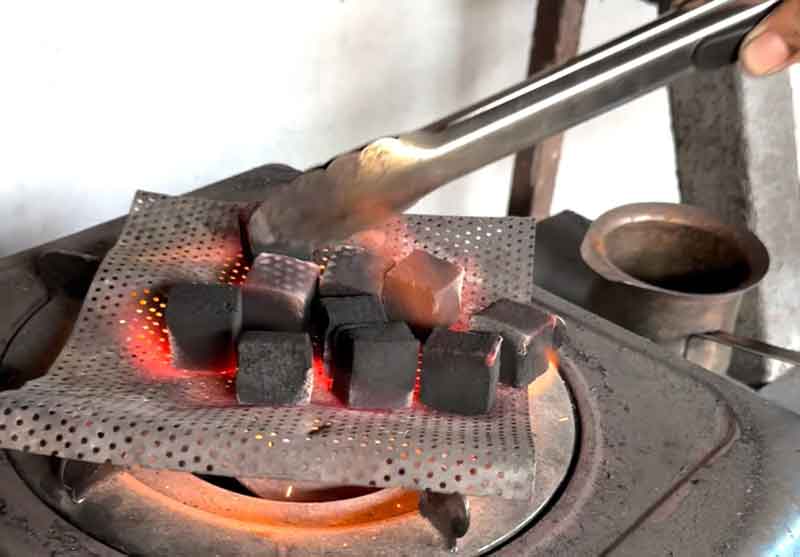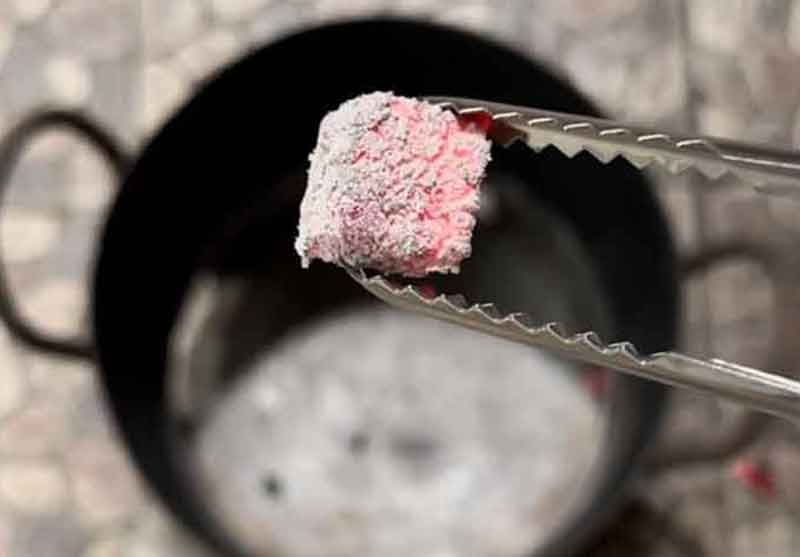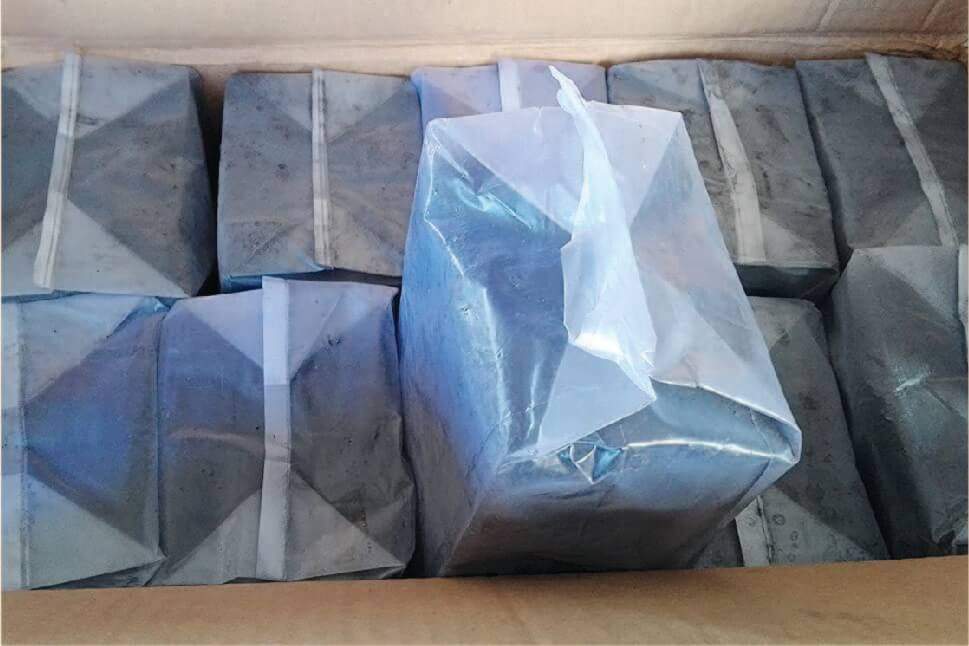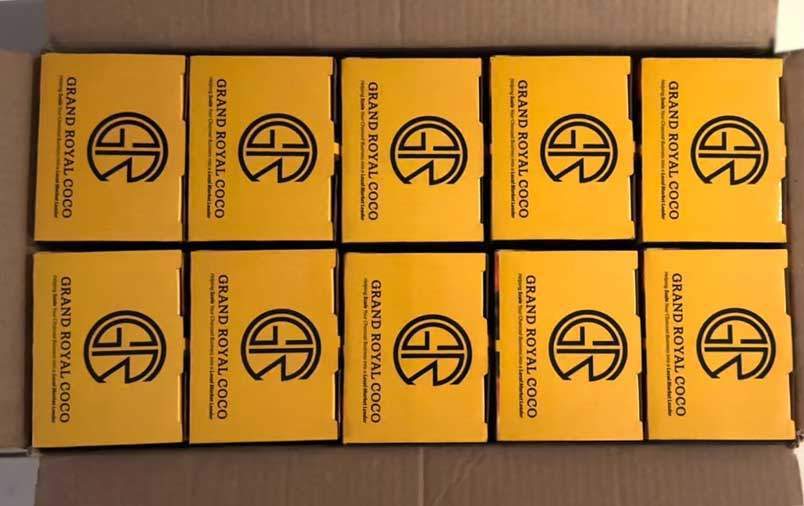At Grand Royal Coco, we solely focus on crafting premium coconut charcoal briquettes for shisha and hookah. We often receive inquiries about whether we offer lower-grade options, less than the premium for cheaper prices, and our response is a resounding “NO”.
We are unwavering in our commitment to producing only premium quality briquettes, ensuring that our customers receive nothing less than the very best. This is reinforced by the feedback from numerous individuals who have put our charcoal to the test. They consistently declared our charcoal as the best they have tried among the many different suppliers they have experimented with.
Our premium coconut charcoal briquettes are made of only the highest quality coconut shell charcoal with a high percentage of fixed carbon above 75% which produces high heat output, perfect for an extended shisha or hookah session. In fact, our customers reported that our premium coconut charcoal briquettes are known to last for 75 – 110 minutes on shisha, providing their shisha enthusiast customers with an extended and satisfying experience.
When you use our briquettes, you will notice that they produce minimal ash during combustion. This not only contributes to a cleaner and more enjoyable experience but also simplifies the post-use cleanup process, saving you time and effort to focus on other tasks that matter most.
Our premium coconut charcoal briquettes are known for being durable and high-quality. This is achieved through our rigorous production methods, high-compression processes, meticulous drying and the application of our special proprietary formula, all of which significantly enhance the hardness and durability of our briquettes. They do not easily crack or break even when subjected to repeated drops or extreme weather conditions.
Due to the low volatile matter content in our premium coconut charcoal briquettes, no smoke, odors or sparks are generated when in use making it the healthiest, cleanest and safest form of charcoal to date. It guarantees a clean, flavorful and pleasant shisha smoking experience for your end customers.
We offer the flexibility to produce our premium coconut charcoal briquettes in various shapes and sizes, including cubes, hexagons, flats, and finger shapes, with or without holes in the center. The cutting process is meticulously carried out with exceptional precision, ensuring uniform and neat results.
We understand that packaging plays a critical role in selling a product. Without excellent packaging, even a remarkable product may struggle to find its place in the market. To meet this challenge, we collaborate with top-notch printing companies with state-of-the-art industrial printing machines to provide various surface finishes, allowing you to customize the packaging to align with your charcoal brand and style. We also offer a range of premium packaging options, including inner plastic bulk packaging for cafes and restaurants and full-color inner boxes with plastic linings for a more polished look for individual use at home.
How to Manufacture Premium Coconut Charcoal Briquettes for Enjoyable Shisha Smoking Experience
Many people have been wondering how to make premium coconut charcoal briquettes, as it may not appear as straightforward as it seems. At a glance, coconut charcoal production may seem relatively easy in comparison to other types of fuel. However, in reality, it is a rather complicated process, especially when it comes to maintaining consistent quality for every shipment.
Not only do we use high quality coconut shell charcoal raw material, but also implement well-organized standard operating procedures and strict quality control measures at all stages of production to ensure that consistently premium quality coconut charcoal briquettes are produced and shipped to our clients.
Let’s go through the step-by-step process that we do daily to produce the world’s premium coconut charcoal briquettes.
1. Prequalifying Coconut Shells and Carbonization
We believe the quality of coconut shell charcoal used in briquette production is the most important factor in determining the quality of the finished products.
In the pursuit of crafting the world’s premium coconut charcoal briquettes, our journey begins with the selection of only the best raw materials. We source our coconut shells exclusively from fully mature, fresh coconuts, harvested from some of Indonesia’s best plantations. Each coconut shell is manually inspected and thoroughly cleaned, ensuring that only the purest raw materials enter our production pipeline. To safeguard their quality, these shells are stored in dry conditions, far from the influence of high temperatures and rain.
To further enhance the quality of our coconut shell charcoal, we educate our partner farmers on a proprietary carbonization technique. This technique results in superior specifications for our charcoal, boasting a high fixed carbon content of around 80%, low volatile matter below 15%, and ash content of 2.5%.
Our commitment to quality does not stop there. When the coconut shell charcoal raw material arrives at our coconut charcoal briquette factory, we engage in a two-step process. We begin by weighing the charcoal to guarantee consistency. Subsequently, we perform a careful burning and testing procedure to discover any potential impurities that may impact the ash quality and color of the finished products. Our firm belief is that making premium coconut charcoal briquettes begins with high-quality shell charcoal raw material.
2. Screening and Milling the Coconut Shell Charcoal
Once inspected, the coconut shells are loaded onto a conveyor belt and passed through a series of screen and mill machines. This comprehensive process efficiently removes unwanted contaminants and debris from the coconut shell charcoal material while uniformly breaking it down into smaller pieces of the desired size, making it more manageable for subsequent processing. The screening process is crucial for separating impurities of different sizes from the coconut shell charcoal, ensuring that the ash content in the briquettes remains well below 2.5%.
The clean coconut shell charcoal particles are then crushed and ground into a fine powder or granules that can be mixed with a binding agent to make premium coconut charcoal briquettes.
3. Mixing and Blending the Charcoal
The fine charcoal powder is subsequently combined with a small percentage of tapioca starch and fresh, purified water in an industrial mixer. The tapioca starch acts as a natural, eco-friendly binder that not only holds the mixture together but also gives the briquettes shape and structure. The charcoal powder and binders are mixed thoroughly to ensure a uniform distribution of all components. Achieving a homogeneous mixture is crucial to ensure that the premium coconut charcoal briquettes have consistent quality and characteristics.
The blending machine uses methods like kneading and stirring to add mechanical force to the mixture. This kneading action involves pushing, folding, and turning, like kneading dough. It helps break down any remaining clumps in the mixture and ensures that the binders and other components are distributed evenly in the charcoal. This blending process improves the texture and consistency of the mixture by making it more compact and harder which is important for forming stable and well-structured briquettes.
The blended mixture is then rested to allow the binding agents to hydrate and bind the components, ensuring consistent consistency and cohesion. It also breaks up any clumps, which makes the briquettes more uniform. This resting period results in high-quality, consistent briquettes that maintain their intended size and shape during the subsequent cutting and drying process.
It is important to emphasize that our premium coconut charcoal briquettes consist solely of 100% natural coconut shell charcoal. We never incorporate wood charcoal, nitrates, sawdust, borax, lime, formaldehyde or other harmful substances into our mixture. Unfortunately, it is not uncommon for some briquette manufacturers to add these additives as fillers, often to cut production costs or artificially enhance briquette characteristics that may improve the briquette’s performance but could potentially pose serious long-term health risks and safety concerns.
Some additives, such as borax or potassium nitrate commonly found in gunpowder, allow the briquettes to ignite more easily and consistently which is desirable for users who want a quick and hassle-free lighting process. However, fast ignition can lead to a shorter burning time, which may not suit those seeking longer-lasting sessions. which can cause shorter burning time and a high risk of fire and health hazards under certain circumstances. Moreover, an overuse of borax or nitrates in the mixture can result in an increased risk of fire and potential health hazards.
Another controversial, harmful additive is formaldehyde. When employed in controlled quantities, formaldehyde can act as a superior binding agent, surpassing tapioca scratch in some respects. It significantly strengthens the structural integrity of the briquettes, ensuring they remain firm and resilient, even in high-heat applications and adverse weather conditions. Additionally, formaldehyde can help deter fungal and mold growth when the briquettes are exposed to high-humidity conditions. However, the use of formaldehyde in charcoal briquettes is both unlawful and strongly discouraged due to its potential carcinogenic properties, which can lead to the development of cancer.
At Grand Royal Coco, we guarantee that our premium coconut charcoal briquettes are 100% natural, releasing no harmful smoke or odors when burned and are safe for health.
4. Molding and Cutting the Charcoal Mixture
After the resting phase, the mixture which has now reached the appropriate level of consistency and cohesion, is fed through a briquetting machine. Here, it undergoes high-pressure compression and takes on the desired shape, whether it is cylindrical, cube, hexagonal or other shapes.
The charcoal is further refined by cutting or slicing it into the final desired length using a precision-engineered rotary cutting blade. The cutting blade spins at a very high speed, quickly and accurately cutting the compressed material into individual briquettes that are all the right size for the final product with straight and smooth edges. This precise cutting makes sure that the premium coconut charcoal briquettes are all the same size and shape, meeting the high quality standards expected by both our factory and the end consumers.
Once shaped to perfection, the premium coconut charcoal briquettes are placed on trays and undergo a crucial resting period for the following reasons. First, it helps the subsequent drying and curing by removing any remaining moisture which is essential for clean and efficient burning. Second, it allows binding agents like tapioca starch to activate fully, which keeps the briquettes’ structure intact. Finally, resting evens out variations in moisture, density, and shape within the batch, ensuring consistent quality among the premium coconut charcoal briquettes.
5. Drying and Curing the Briquettes
The premium coconut charcoal briquettes are then subjected to a carefully controlled drying process in specially designed ovens with controlled temperature and airflow. This step is essential to further reduce the moisture content, ensuring that the briquettes achieve the desired dryness level.
The goal is to achieve a moisture content well below 6% or lower. Lower moisture content is critical as it not only helps the premium coconut charcoal briquettes burn cleanly and efficiently but it also stops mold or fungus from growing especially when stored in humid environments.
After being dried in the oven, the premium coconut charcoal briquettes are not immediately packaged for distribution. Some residual moisture may still be present in the briquettes. Therefore, the premium coconut charcoal briquettes must go through a crucial curing period that lasts for 24 – 48 hours, allowing them to rest, stabilize and properly solidify.
Curing allows the premium coconut charcoal briquettes to continue to lose any remaining moisture, ensuring they reach their optimal dryness level for efficient burning. If briquettes are not completely dried and are immediately packaged as soon as they cool down coming out of the oven, they retain internal moisture. Upon heating for shisha use, this residual moisture rapidly evaporates, causing the briquettes uneven expansion and deep cracks. These cracks affect both aesthetics and functionality, compromising burn efficiency and making them more susceptible to breakage during use.
Curing also helps solidify the briquettes and maintain their structural integrity by enabling binding agents, such as tapioca starch, to fully activate and ensure the briquettes remain intact. This prevents breakage during handling, packaging, and transportation.
6. Quality Control
Quality control testing is a non-negotiable aspect of the production process when it comes to premium coconut charcoal briquettes. While we pay attention to quality at every step of the production process, inspections carried out after the briquettes have been dried are the most important part of making sure that the finished product meets all of our high standards.
We regularly sample the cured briquettes from each batch and perform the following tests to maintain consistent quality across batches using specific success indicators. Any batch that does not pass these tests will be rejected and recycled.
Moisture Content
To calculate the moisture content, first, weigh a sample of the premium coconut charcoal briquettes to determine its initial weight. Then, place the same sample in an oven set at around 105°C (221°F), and let it dry for a designated period. After the drying period, weigh the sample again. The moisture content is calculated using the following formula:
Moisture Content (%) = ((Initial Weight – Final Weight) / Initial Weight) x 100
This calculation gives you the percentage of moisture in the sample, providing essential information about the briquettes’ dryness level. We only accept the entire batch if the samples have a moisture content of less than 6%.
Ash Content
To calculate the ash content in coconut charcoal briquettes, samples of the premium coconut charcoal briquettes are burned at around 600 – 650°C (1,112 – 1,202°F) until they completely turn into ash. Cool the samples down and keep them in an enclosed, dry environment to prevent them from absorbing moisture. The remaining ash is weighed. The ash content is calculated using the following formula:
Ash Content (%) = (Weight of Ash / Weight of Original Sample) x 100
In order for us to approve a batch, the samples must have a moisture content of 2.5% or below. By doing so, we can guarantee that our briquettes generate very little ash and provide a clean and enjoyable experience for your end customers.
Ash Color
To assess the ash color, the premium coconut charcoal briquettes are burned on a stove for 10 – 15 min until they are burned evenly on all sides. Crucially, this examination takes place outdoors under natural sunlight, rather than artificial indoor lighting to ensure the ash color we observe is accurate.
Depending on our customer’s requirement, the ash color can be white or light grey.
The ash color of the premium coconut charcoal briquettes only affects their aesthetics. Unlike ash content, the ash color does not have any impact on their performance or burning characteristics.
Odor
It is essential to take note of any odors produced while they burn. Premium coconut charcoal briquettes should burn cleanly without emitting any unpleasant smells that may indicate the presence of harmful substances that may have adverse effects on health.
It is important to note that, a slight odor is to be expected in the first few minutes of burning. This is usually related to the tapioca flour used in the briquette binding process. Generally, any such smells should fade after a few minutes of burning, ensuring a safe and pleasant experience for the end consumers.
Burning Time and Glow
After the premium coconut charcoal briquettes are burned evenly on a stove for 10 – 15 min, leave them to rest while allowing them to sustain the burn and record the time it takes for them to completely transform into ash. Our premium coconut charcoal briquettes should last at least 2 hours on standby while our customers have reported they last between 75 – 110 minutes when used on shisha depending on their usage.
When burning, premium coconut charcoal briquettes should demonstrate a consistent, even, and vibrant red glow which indicates high burning efficiency.
Deep Cracks and Black Spots
It is important to carefully look at the surface of burning coconut charcoal briquettes for any signs of deep cracks or unburned spots, also known as “black spots.” These imperfections can hurt the briquettes’ ability to burn efficiently and maintain their shape. Briquettes with deep cracks are more likely to break apart when subjected to pressure or handling. If briquettes have unburned spots, they will not burn uniformly leading to uneven heat distribution and negatively affecting the satisfaction of the end consumers.
Drop Test
Drop test is an important quality control method for evaluating the density and hardness of our premium coconut charcoal briquettes. A selection of of briquettes are dropped from a height of 1 meter three times. 80% or more of these briquettes should pass this test without breaking.
Not only does this test not replicate the mechanical stress they may experience during handling, but also the potential challenges that extreme weather could cause. In particular, it helps evaluate how well the briquettes hold up in very dry conditions, which can cause them to crack from drying out too quickly. By doing the drop test, we ensure that our briquettes maintain their shape and perform well under different challenging conditions.
7. Packing the Premium Coconut Charcoal Briquettes
Once our premium coconut charcoal briquettes successfully pass all quality control tests, they are ready for the final stage: packaging. Our dedicated packaging team takes great care in placing each briquette into inner plastic packaging. This meticulous process represents the final visual inspection, where we scrutinize every briquette for surface imperfections, cracks, or irregularities and exclude them from the packaging.
It is important to keep the packaging airtight to effectively prevent the exchange of air between the inside and outside of the package, preserve the charcoal quality and stop moisture from getting in, to ensure a consistent and enjoyable shisha experience.
We offer two main packaging options tailored to each client’s preferences. The first involves packing the briquettes in inner plastic bags, with each bag containing 1 kg of product. These individual bags are then grouped into master cartons, which are available in either 10 kg or 20 kg sizes. This type of packaging is suited for selling to shisha restaurants, cafes or bars. The second type of packaging requires full-colored inner boxes with inner plastic lining to hold the desired briquette weight whether 250 gr, 500 gr or 1 kg before being placed into master cartons. This premium packaging option is suited for individual shisha enthusiasts at home.
Once the samples are packed, Carsurin takes the lead in the sampling process. Their expert team ensures precise and careful sample collection, maintaining the product’s integrity. After conducting a series of tests in their laboratory, they will issue a Standard Heating Test Report and Certificate of Analysis, detailing essential characteristics of the charcoal such as moisture content, ash content, volatile matter, and fixed carbon. These test results are sent to the shipping company to ensure our products meet the required standards before they grant the approval for shipping. We will also forward these detailed reports to our clients for every shipment so they can maintain records of the quality of charcoal they are getting.
Partnering with Our Factory: Building, Growing, and Scaling Your Private Label Charcoal Business
With over a decade of industry experience, we prioritize unwavering quality control in every step of our process. From the selection of high quality coconut shell raw material to meticulous packaging, we adhere to key success indicators to ensure top-notch product integrity. Our customer service is highly responsive and committed to addressing any concerns or issues. We actively listen and value client feedback as an essential tool to continually enhance the quality of our premium coconut charcoal briquettes and constantly re-align with changing market preferences.
Over the years, our steadfast dedication to high quality standards and exceptional service has been exemplified through our successful exports to over ten countries spanning five continents. We’ve accomplished this while upholding stringent adherence to legal shipping standards, declaring our products as charcoal, with no instances of misdeclaration. Our commitment to providing premium-quality goods and surpassing customer expectations has firmly established our reputation as a trustworthy and respected global market partner.
If you are looking to create the perfect charcoal product for your market and grow your charcoal business to the next level, get in touch with us today and find out how we can help you with your business.















